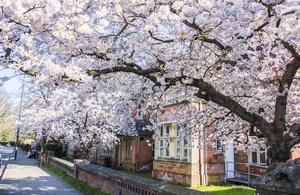Economic value of the UK’s individual trees revealed for first time
Trees planted outside woodlands are worth over £3.8 billion, groundbreaking research published by Forest Research and Defra reveals

Trees outside woodlands are defined as single trees in urban and rural areas and are some of the most iconic trees in our landscape, ranging from the classic, spreading hedgerow to single trees lining our streets. (Credit: Forestry Commission)
The economic value of individual trees planted outside of our forests and woodlands has been revealed for the first time today (Sunday 4 December) at £3.8 billion. The figures are revealed in a new groundbreaking study published by Forest Research and Defra as part of National Tree Week.
Trees outside woodlands are defined as single trees in urban and rural areas and are some of the most iconic trees in our landscape, ranging from the classic, spreading hedgerow to the single trees lining our streets, making up almost a quarter of trees in Great Britain.
The valuation is based on the important role they play in sequestering and storing carbon, regulating temperatures, strengthening flood resilience and reducing noise and air pollution. Together, these help to mitigate against climate change, reducing damage to infrastructure and people from the impact of flooding, cooling our cities in summer and improving health and wellbeing.
By quantifying their significant value, the report will help to incentivise councils, land managers and local communities to plant more trees outside of woodlands for the varied and numerous benefits they provide. As outlined in our England Trees Action Plan, this will contribute to wider Government efforts to treble planting rates in England by the end of this Parliament and achieve net zero by 2050.
Forestry Minister Trudy Harrison said:
Today’s groundbreaking research reaffirms the unique value of non-woodland trees which exist all around us - from the trees lining our streets to those dotted around our beautiful countryside.
It makes clear the immense environmental and economic value and benefits trees bring to society which cannot be underestimated. As set out in our England Trees Action Plan, we have committed to trebling tree planting rates in England by 2024 and by quantifying the significant value of trees, this research will help to incentivise planting in our communities across our country.
Kieron Doick, Head of the Urban Forest Research Group, Forest Research said:
Trees outside of woodlands are all around us: in our gardens, along our roads, in our parks and open green spaces. Understanding their value can help make sure councils and landowners invest in the planting of more trees, and their aftercare so that they may continue to provide us with their abundant beauty and benefit.
While our valuation of non-woodland trees is substantial, we recognise that our research valued just a handful of the many benefits that trees provide. Future research will allow greater understanding and increased values as more of the benefits are included.
Our report shows that trees are valuable infrastructure assets across multiple land uses, much as one might think about lampposts or drains. Moreover, it highlights the much greater role of mature trees in delivering benefit to society - in comparison to their younger counterparts.
Richard Stanford, Chief Executive, Forestry Commission, said:
This first-of-its-kind research demonstrates the dynamism of trees outside woodlands – from tackling many of the prevailing issues of our time, like air quality and climate change, to damping down noise and helping people to get a better night’s sleep.
This landmark report will inform the continued rollout of our England Trees Action Plan and be instrumental to future policymaking. Continuing to make informed decisions based on robust scientific evidence will help us to realise the numerous environmental, economic and social benefits that trees provide – now and in the future.
The report also estimates the Natural Capital Value of non-woodland trees to be between £68.5 billion and £151.5 billion, in 2020 prices. This represents the value of the trees over the course of a century and provides a useful means of comparison to other natural assets.
In 2021/22, over half a million trees were planted outside of woodlands thanks to Government grants, such as the Urban Tree Challenge Fund, boosting deprived urban areas; the Local Authority Treescapes Fund accelerating tree planting in local communities; and the Levelling Up Parks Fund which helps people across England to benefit from spending time in nature.
‘Valuing Non-Woodland Trees’ is available to download free-of-charge on the Forest Research website.